Tentative list of speakers and their presentations (where available) in no particular order…
Steve Moyer, Trout Unlimited, “Reflecting on 20 Years of Reclamation Success”
Keynote Address – As Trout Unlimited’s senior advocate on Capitol Hill and with federal agencies, Steve works with TU’s local chapters and state councils to help them with their state and local advocacy efforts. He develops and implements TU grassroots advocacy campaigns. Steve has worked for TU for 19 years and prior to joining TU, he led advocacy efforts at the National Wildlife Federation on behalf of fisheries, and wetlands, and related appropriations legislation. He holds a B.S. in Wildlife Management from the University of Maine and an M.S in Fisheries from Virginia Tech.
Anne Daymut, WPCAMR and Robert Hughes, EPCAMR, “A Reclamation Conversation”
Robert and Anne will facilitate a conversation to discuss Pennsylvania’s success in reclamation over the last 20 years and identify goals for the future.
Tom Gray, Tetra Tech Inc., “Coal and Coal Mine Wastes, a Resource for Rare Earth Elements?”
Rare Earth Element’s (REE) are important strategic and critical materials utilized in many high-technology applications including defense and renewable energy. Production of REE currently is dominated by China. Data publicly available data from the USGS was used to determine that REE are present in many coal basins of the United States. Study results conclude that REE occurrences in coal and associated waste materials has the potential of being a domestic source of rare earth elements and could add a potential new revenue stream to existing coal mining operations.
Robert Hughes, EPCAMR, “Watershed Group Funding through PA’s Educational Improvement Tax Credit Program”
PA’s Department of Community and Economic Development is administering educational program grants through the Educational Improvement Tax Credit Program (EITC). EPCAMR will share their experience with the program and walk you through the application process for this new source of environmental education funding.
Jacob Johnson et al, Penn State University, “Case Study to Assess the Costs of the Appalachian Regional Reforestation Initiative’s (ARRI) Forest Reclamation Approach”
Conventional methods of reclamation in the Appalachian region have been shown to inhibit the growth of forest trees on post surface-mined land. Unsuitable topsoil substitutes, high rates of soil compaction, as well as the use of fast-growing groundcovers create unfavorable conditions for tree growth. The ARRI has developed a process known as the Forestry Reclamation Approach (FRA) to address these problems and promote the restoration of healthy forests. The FRA emphasizes the placement of at least four feet of uncompacted rooting medium, slow-growing groundcovers, and the use of professional tree-planting techniques. Despite the obvious ecological advantages of the FRA, there is no single source presenting a complete economic analysis of the technique compared to conventional reclamation practices. A case study is currently being conducted to compare costs of the two reclamation approaches in Pennsylvania, where mining occurs mainly on previously-forested land. Real-time cost analyses on several active mines will assess appropriate spoil materials, grading, and seeding/planting. Active mine data from Pennsylvania will be paired with a compilation of regional industry data from representative Southern, Central, and Northern mining operations. Data will illustrate material handling, grading, soil amendment requirements, groundcover establishment, tree planting, and maintenance of sediment control structures. Preliminary results will be presented and implications discussed. The importance of this work is to show landowners and operators that they have options, other than conventional reclamation, that result in productive long-term benefits and the restoration of sustainable native forests.
Peter Smyntek et al, St. Vincent College, “Screen to Stream – Student citizen scientists explore local watersheds online & outdoors”
Screen to Stream is a new PA Department of Environmental Protection (DEP)-funded environmental education initiative by Saint Vincent College and the Winnie Palmer Nature Reserve in partnership with the Loyalhanna Watershed Association, the Conemaugh Valley Conservancy and regional school districts. This project aims to develop an aquatic ecosystem exploration program comprised of an interactive virtual learning lab, mobile apps and practical lessons with accompanying teacher development materials for students in grades 3-12. Students will learn how to be citizen scientists and assess the health of local streams by observing key biological and chemical indicators of common water quality problems in Pennsylvania. Engaging programs on abandoned mine drainage and other water quality issues, such as Goodbye Orange Water and Nature Interrupted, that were previously developed with PA-DEP grants will be made accessible through an interactive virtual learning lab. These interactive materials will introduce children to science concepts such as watershed geology, chemistry, ecology and environmental stewardship and inspire them to explore their local watersheds and become citizen scientists. A draft of the Screen to Stream website and associated learning materials are being developed, and feedback from water quality researchers and environmental educators would be greatly appreciated.
Andrea Nerozzi , Wyoming Seminary Upper School, “Developing Partnerships with High Schools”
Education is an important aspect of environmental organizations. Indeed, most of these groups include successful outreach programs to local schools and communities. However, many of these programs are targeted at elementary and middle school level students. Although programming and materials are available for high school students, they vary in quality and content. Over the past few years, I have partnered with EPCAMR in educational programming aimed at high school students. In this presentation, I will discuss a series of activities that utilize resources provided by EPCAMR to introduce AP Environmental Science students to geology, mining and the problems associated with abandoned mining operations. Some of these activities are novel, and others extend material already available through EPCAMR. From this specific example, the general characteristics of activities appropriate for high schools students will be discussed. I am advocating that active partnerships with high school teachers could yield educational resources that allow more advanced students to address the science and engineering involved in environmental remediation on a more technical level, and serve to create interest in careers in this field. Students trained through this programming could serve as volunteers and associates for additional outreach programs or could become directly involved in the organizations.
Andrew Friefeld, Temple University, “Restoring the Black Desert: A novel approach to reclaiming AML in Northeastern PA”
The Black Desert, a 110 acre refuse pile in Exeter, PA has sat idle for over 40 years. It has been selected as a master’s thesis project that will focus on honoring cultural heritage of the region, fostering economic development, and promoting ecological restoration to make the site a community asset. This non-traditional design solution will highlight resilient thinking and sustainability in land use planning for the site.
Tom Clark, Susquehanna River Basin Commission, “Susquehanna River Basin Mine Drainage Data Portal: Additions and Improvements for 2018”
Link to “Beta” Mine Drainage Portal
In 2017, the Susquehanna River Basin Commissioner (SRBC) partnered with the United States Army Corps of Engineers on an internally funded project to upgrade SRBC’s online and publically accessible Mine Drainage Data Portal. Improvements include additional coverages (i.e. high quality/exceptional value streams, wild trout, Class A, coal permit information), scrolling coordinate system, a tool to locate your position in the field, and layouts that fit and function on smartphones and tablets. The Mine Portal currently has water quality results for 1,327 AMD discharge and 2,404 stream stations throughout the Susquehanna River Basin. The presentation will be a demonstration on the classic and updated functions as well as how the Mine Portal can now be easily used in the field on handheld devices.
Beth Berkhouser, Interdependence Hexagon Project, “Connecting Art – Creating Solutions: A Hexagonal, In-Depth Inquiry into AMD for the Classroom”
The Hexagon Project is an International Social Justice opportunity for teachers, students and communities worldwide. A 501[3][c] non-profit, our mission is to spread the meaning of interdependence through school and community created hexagons. Themes of social justice, identity, peace and the environment are expressed, through the power of the arts, in an increasingly interconnected world. Hexagons are metaphors for interconnectedness.
Mike Korb, Tetra Tech, Inc., “How to Give the Best Field Trip Ever”
Your conferences and meetings SHOULD include a tour or field trip and it should be one that is remembered, Instagrammed, and talked about for years to come. Planning a successful field trip, however, takes more than a couple of phone calls and a stack of permission forms. This talk will help you plan an exciting, extraordinary, and safe learning experience for your trippers.
Jaret Gibbons, ARIPPA, “Environmental Benefits of the Coal Refuse Industry”
The coal refuse to energy industry plays a vital role in the cleanup efforts of abandoned mine lands (AML) and acid mine drainage (AMD) in Pennsylvania. Since its inception, the industry has removed and burned as fuel more than 200 million tons of coal refuse, improved or restored more than 1,200 miles of streams, and reclaimed more than 7,000 acres of abandoned mine lands in Pennsylvania alone. This presentation will focus on the environmental benefits achieved during the completion of specific reclamation projects undertaken by the industry.
Tim Altares, PA DEP BAMR, “Pennsylvania’s Abandoned Coal Mine Fires”
An overview of the location/occurrences of abandoned coal mine fires in Pennsylvania; a description of the fire types and hazards associated with abandoned coal mine fires; and a description of DEP’s BAMR’s typical efforts to investigate, monitor and reclaim abandoned coal mine fire sites.
David Thomas and Donald Hedge, Broad Top Township, “Passive Treatment System Maintenance”
Broad Top Township has constructed over 35 passive treatment systems over 20 years and maintains these systems. The Township has gained valuable experience and would like to share this knowledge. This would be a power-point presentation that illustrates various maintenance techniques.
Rachael Grube, EPCAMR, “New Methods for Digitizing Mine Maps”
Through our work with the state Mine Subsidence Insurance program, EPCAMR is creating digital versions of historic anthracite mine maps. In order to create a user-friendly database of mine maps, mined out areas, mine working elevations, and mine openings, the DEP has developed new GIS mapping protocols and maps are pieced together into a puzzle-like “mosaic,” where the best maps from each area are chosen. This mosaicking process will allow homeowners to investigate abandoned mines under their properties more easily.
Daniel Bochicchio, Skybernetics, “Valuable Insights from On High: Drone use in AMR”
Skybernetics anticipates drones to be tools as useful to geologists as the compass or Geographical Information Systems (GIS) – our passion is putting that tool to use and giving environmental stewards the next level of data they need to do accurate, faster, and more cost-effective work. Topics covered will include water quality, thermal imagery as a tool for highlighting AMD discharge zones and short-circuits within remediation systems, updating and enhancing aerial imagery, and 3D data visualization and modeling for engineering, and geologic investigations.
Joe Pizarchik, “Preserving Decades for Success; A Plan for O&M Funding”
We will cover two possible ways to obtain long-term operation and maintenance funds for abandoned mine drainage treatment systems constructed by watershed groups these past decades. We will also discuss various steps to preserve your investments in water pollution reductions. An open discussion is welcomed and encouraged.
Eric. E. Cavazza, P.E., Director, PA DEP, Bureau of Abandoned Mine Reclamation, “The AML Pilot Program in Pennsylvania”
The Abandoned Mine Land (AML) Pilot Program, authorized by Congress, provided $30 million for federal fiscal year 2016 (FY2016) and $25 million for FY2107 to Pennsylvania (PA) for the reclamation of abandoned mine lands in conjunction with economic and community development and reuse goals. PA targeted the FY2016 AML Pilot funding to fourteen (14) projects and the FY2017 AML Pilot funding to twelve (12) projects. Nearly all of the AML Pilot Program funds are being allocated for the reclamation/restoration of SMCRA Title IV eligible AML and AMD problems. Project partners are then responsible to fund and complete non-AML economic development aspects of the projects. This presentation will discuss each of the AML Pilot Projects and anticipated benefits as well as the status of each including project implementation successes, challenges, and lessons learned

